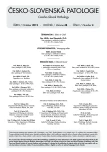Vliv glukokortikoidového receptoru na hyperpyrexii navozenou metamfetaminem
Autoři:
S. Yoshida 1; H. Kinoshita 2; T. Tatara 1; C. Tashiro 1; M. Nishiguchi 3; H. Ouchi 3; T. Minami 3; S. Hishida 3
Působiště autorů:
Department of Anesthesia, Hyogo College of Medicine, 1-1, Mukogawa-cho, Nishinomiya, Hyogo, 66 -8501, Japan
1; Department of Forensic Medicine, Faculty of Medicine, Kagawa University, 1750-1, Ikenobe, Miki, Kita, Kagawa, 761-079 , Japan
2; Department of Legal Medicine, Hyogo College of Medicine, 1-1, Mukogawa-cho, Nishinomiya, Hyogo, 663-8501, Japan
3
Vyšlo v časopise:
Soud Lék., 57, 2012, No. 4, p. 66-68
Kategorie:
Původní práce
Souhrn
Byl zkoumán vliv glukokortikoidu na metamfetaminem (MA) navozenou hyperpyrexii
s užitím bio-telemetrického systému. Prokazatelná úroveň hyperpyrexie byla pozorována u krys, kterým byl podáván MA. Naproti tomu vzestup tělesné teploty byl potlačen adrenalektomií nebo podáváním RU-486, tj. antagonisty glukokortikoidového receptoru. Tyto údaje nasvědčují, že glukokortokoidový receptor může být odpovědný za hyperpyrexii navozenou metamfetaminem.
Klíčová slova:
metamfetamin – hyperpyrexie – glukokortikoidy – kortikosteron
Zdroje
1. Baselt RC. Methamphetamine. In: Drug effects on psychomotor performance. Foster City, CA: Biomedical Publications, 2001, pp. 244–246.
2. Wada K, Ozaki S, Kondo A. Current situation of drug abuse/dependence and political task against it. Nihon Arukoru Yakubutsu Igakkai Zasshi 2008; 43: 120–131.
3. Karch SB. The pathology of drug abuse (2nd ed). Boca raton: CRC press; 1996: 199–230.
4. Kojima T, Une I, Yashiki M, Noda J, Sakai K, Yamamoto K. A fatal methamphetamine poisoning associated with hyperpyrexia. Forensic Sci Int 1984; 24: 87–93.
5. Westfall TC, Westfall DP. Adrenergic agonists and antagonists. In: Brunton LL, Lazo JS, Parker KL. eds. Goodman & Gilman’s The pharmacological basis of therapeutics (11th ed). New York: McGraw-Hill; 2006: 237–295.
6. Matsumoto C, Griffin W. Antagonism of (+)-amphetamine-induced hyperthermia in rats by pimozide. J Pharm Pharmac 1971; 23: 710.
7. Yamawaki S, Lai H, Horira A. Dopaminergic and Serotonergic mechanisms of thermoregulation: mediation of thermal effects of apomorphine and dopamine. J Pharmacol Exp Ther 1983; 227: 383–388.
8. Uchima E. Physiologic stidies on acute methamphetamine poisoning. Nihon Hoigaku Zasshi 1984; 38: 814–826.
9. Makisumi T, Yoshida K, Watanabe T, Tan N, Murakami N, Morimoto A. Sympatho-adrenal involvement in methamphetamine-induced hyperthermia through skeletal muscle hypermetabolism. Eur J Pharmacol 1998; 363: 107–112.
10. Harbuz MS, Lightman SL. Stress and the hypothalamo-pituitary-adrenal axis: acute, chronic and immunological activation. J Endocrinol 1992; 134: 327–339.
11. Knych ET, Eisenberg RM. Effect of amphetamine on plasma corticosterone in the conscious rat. Neuroendocrinology 1979; 29: 110–118.
12. Swerdlow NR, Koob GF, Cador M, Lorang M, Hauger RL. Pituitary-adrenal axis response to acute amphetamine in the rat. Pharmacol Biochem Behav 1993; 45: 629–637.
13. Williams MT, Inman-Wood SL, Morford LL, et al. Preweaning treatment with methamphetamine induces increase in both corticosterone and ACTH in rats. Neurotoxicol Teratol 2000; 22: 751–759.
14. Roth J. Endogenous antipyretics. Clin Chim Acta 2006; 371: 13–24.
15. Takahashi A, Ishimaru H, Ikarashi Y, Kishi E, Maruyama Y. Opposite regulation of body temperature by cholinergic input to the paraventricular nucleus and supraoptic nucleus in rats. Brain Res 2001; 909: 102–111.
16. McCullers DL, Sullivan PG, Scheff SW, Herman JP. Traumatic brain injury regulates adrenocorticosteroid receptor mRNA levels in rat hippocampus. Brain Res 2002; 947: 41–49.
17. Kinoshita H, Harbuz MS, Nishiguchi M, et al. High alcohol preferring (HAP) and low alcohol preferring (LAP) rats show altered proopiomelanocortin (POMC) messenger RNA expression in the arcuate nucleus. Alcohol Alcohol 2004; 39: 406–409.
18. Buckingham JC. Glucocorticoids: exemplars of multi-tasking. Br J Pharmacol 2006; 147: S258–S268.
19. Coelho MM, Souza GEP, Pela IR. Endotoxin-induced fever is modulated by endogenous glucocorticoids in rats. Am J Physiol 1992; 263: R423–427.
20. Sprague JE, Mallett NM, Rusyniak DE, Mills E. UCP3 and thyroid hormone involvement in methamphetamine-induced hyperthermia. Biochem Pharmacol 2004; 68: 1339–1343.
21. Gong DW, He Y, Karas M, Reitman M. Uncoupling protein-3 is a mediator of thermogenesis regulated by thyroid hormone, beta3-adrenergic agonists and leptin. J Biol Chem 1997; 272: 24129–24132.
22. Rousset S, Alves-Guerra M-C, Mozo J, et al. The biology of mitochondrial uncoupling proteins. Diabetes 2004; 53 (Suppl.1): S130–S135.
23. Ricquier D, Bouillaud F. The uncoupling protein homologues: UCP1, UCP2, UCP3, StUCP and AtUCP. Biochem J 2000; 345: 161–179.
24. Sun X, Wray C, Tian X, Hasselgren PO, Lu J. Expression of uncoupling protein 3 is upregulated in skeletal muscle during sepsis. Am J Physiol Endocrinol Metab 2003; 285: E512–E520.
Štítky
Patologie Soudní lékařství ToxikologieČlánek vyšel v časopise
Soudní lékařství

2012 Číslo 4
Nejčtenější v tomto čísle
- Fatální případ abusu sirupu proti kašli
- Náhlé úmrtí při vzácném mozkovém nádoru: Případ z pitvy
- Dvojí výročí v českém soudním lékařství
- Neobvyklé poranění hlavy a krku ve výtahu
